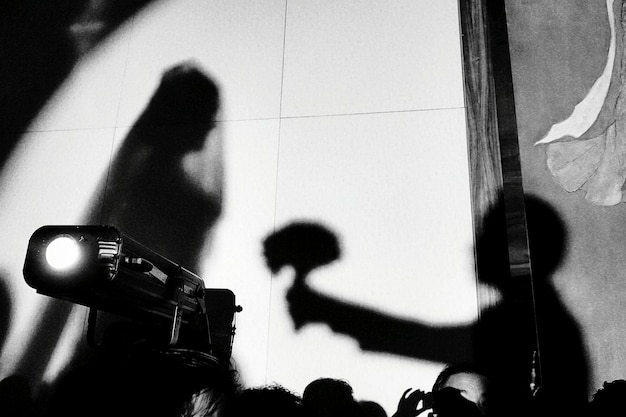The Art of the Diss Track: Rap Battles for Feuds & Talent

The art of the diss track, a cornerstone of hip-hop, serves as a dynamic arena where artists strategically deploy verbal prowess and lyrical dexterity to settle disputes, assert dominance, and dramatically showcase their exceptional talent within the competitive landscape of rap.
In the vibrant tapestry of hip-hop, few phenomena capture the raw intensity and creative genius quite like the art of the diss track: how rap battles are used to settle feuds and showcase talent. These lyrical confrontations transcend mere arguments, evolving into meticulously crafted sonic missiles designed to dismantle reputations and elevate lyrical supremacy. It’s a compelling blend of artistry, strategy, and unadulterated passion, defining pivotal moments in music history.
The anatomy of a diss track: more than just insults
A diss track is far more intricate than a simple insult set to a beat. It’s a calculated attack, a lyrical chess match where every line serves a purpose. From intricate wordplay and double entendres to direct accusations and comedic jabs, its construction demands precision and wit. The most effective diss tracks are memorable not just for their aggression, but for their cleverness and undeniable artistry.
Lyrical craftsmanship and storytelling
At its core, a diss track is a testament to an artist’s storytelling ability. It requires weaving a narrative that exposes flaws, recounts past grievances, and ultimately positions the dissenter as superior. This often involves deep dives into an opponent’s history, public image, and even personal life, all framed within a compelling lyrical structure.
- Wordplay and punchlines: The backbone of a strong diss, these are designed for maximum impact and quotability.
- Personal anecdotes: Often used to add authenticity and emotional weight to the attack.
- Metaphors and similes: Employed to subtly or overtly degrade the opponent’s artistic or personal standing.
The strategic deployment of these elements distinguishes a truly impactful diss track from a fleeting online beef. It’s about building a case, line by line, that leaves no doubt about the victor in the lyrical exchange. The goal is to not only win the battle but to etch the victory into the annals of hip-hop history.
A rapper’s reputation often hangs in the balance during these exchanges. The ability to articulate grievances, expose hypocrisy, and deliver devastating blows through clever rhymes can solidify one’s place as a lyrical giant. Conversely, a poorly executed diss can be detrimental, revealing a lack of skill or confidence. Thus, the creative process behind these tracks is often intense, involving days or even weeks of meticulous writing and rewriting to ensure every syllable hits its mark.
Delivery and vocal performance
Beyond the words themselves, how they are delivered is paramount. The tone, inflection, and aggression in a rapper’s voice can amplify the impact of the lyrics, conveying disdain, confidence, or cold fury. A weak delivery can undermine even the most potent lines, while a strong, conviction-filled performance can elevate mediocre lyrics.
The flow, rhythm, and cadence also play a critical role. A well-timed pause, an unexpected change in pace, or a particularly aggressive vocal emphasis can make a diss unforgettable. This multi-layered approach to creating a diss track highlights why it is considered an art form, demanding mastery over various aspects of vocal performance and lyrical construction.
Historical context: from street battles to global stages
The origins of diss tracks are deeply rooted in the competitive spirit of hip-hop’s nascent days, moving from localized street battles to commanding global attention. These early exchanges, often impromptu and raw, laid the groundwork for the more polished, commercially released diss tracks we know today. The transformation reflects the genre’s evolution, from a subculture to a mainstream phenomenon, yet the core essence of lyrical confrontation remains.
The evolution of battle rap
Battle rap, in its purest form, has always been about proving lyrical dominance. From the schoolyards of the Bronx to the organized leagues of today, emcees have used their words as weapons. This tradition naturally extended into recorded music, allowing artists to reach a wider audience with their lyrical disputes. The transition from live, spontaneous battles to studio-produced diss tracks brought a new level of polish and permanence to these feuds.
Early examples often manifested as subtle jabs embedded within album tracks, evolving into dedicated songs as rivalries intensified. This progression saw artists meticulously crafting their responses, elevating the art form from raw street rhetoric to a calculated showcase of lyrical precision and strategic foresight. The stakes grew higher, with careers sometimes hanging on the outcome of these lyrical confrontations.
- Early cyphers: Informal gatherings where MCs honed their skills, often engaging in friendly or competitive exchanges.
- Live performances: Rappers would call out rivals during concerts, testing their ability to respond on the spot.
- Recorded tracks: The ultimate evolution, allowing diss tracks to be disseminated widely and preserved indefinitely, cementing their place in hip-hop lore.
This historical trajectory underlines the enduring appeal of diss tracks, demonstrating how they’ve served as a consistent barometer for lyrical prowess and a captivating spectacle for fans. They are not merely musical pieces but historical documents of hip-hop’s competitive spirit.
Iconic feuds and their impact
Throughout hip-hop history, numerous feuds have been immortalized through diss tracks, shaping careers and even the direction of the genre. These battles were more than personal animosities; they were ideological clashes, territorial disputes, and intense competitions for artistic supremacy. The heightened tension and intense media scrutiny surrounding these feuds often served to amplify the impact of the diss tracks themselves.
Consider the East Coast vs. West Coast rivalry of the 1990s, a period where diss tracks reached an unparalleled level of cultural significance. Artists like Tupac Shakur and The Notorious B.I.G., icons of their respective coasts, engaged in lyrical warfare that captivated the nation. Their exchanges, particularly songs like “Hit ‘Em Up” and “Who Shot Ya?”, did more than just settle personal scores; they became anthems for entire regions, illustrating the profound cultural resonance of these artistic confrontations.
These seminal moments underscore how diss tracks can transcend mere musical rivalry to become part of the broader cultural narrative, reflecting societal tensions, regional pride, and the fierce individualism characteristic of hip-hop. The legacies of these feuds continue to influence and inspire new generations of artists, proving that the pen, when wielded by a skilled MC, can be mightier than the sword.
The dual purpose: settling feuds and showcasing talent
Diss tracks brilliantly serve a dual function in the hip-hop landscape: they act as a forum for settling personal and professional feuds while simultaneously providing an unparalleled stage for artists to display their lyrical prowess and creative genius. This unique interplay makes them a fascinating aspect of the genre, offering insights into artist dynamics and the competitive spirit that drives innovation.
Conflict resolution, hip-hop style
In a genre born from expression and competition, diss tracks offer a structured, albeit aggressive, method of conflict resolution. Rather than resorting to physical violence, artists channel their frustrations, anger, and grievances into lyrical combat. This transformation of potential street brawls into artistic showdowns highlights hip-hop’s power to sublimate aggression into creative output.
Through diss tracks, artists can air their grievances publicly, defend their reputations, and challenge perceived slights. The public nature of these feuds means that the outcome is often decided by public opinion and the perceived lyrical victory, adding another layer of pressure and authenticity to the process.

The catharsis for both the artists and the fans is palpable. For the artists, it’s an opportunity to vent and reclaim their narrative. For the fans, it’s pure entertainment, a gladiatorial contest of words where the stakes are high, and the outcome is uncertain until the final bars are laid down.
A battle for supremacy
Beyond settling beef, diss tracks are ultimate showcases of artistic skill. A rapper’s ability to craft a devastating diss—one that is clever, impactful, and undeniable—can solidify their position as a lyrical heavyweight. It’s a direct challenge to an opponent’s talent and often serves as a proving ground for new techniques, flows, and lyrical approaches.
- Lyrical dexterity: Demonstrating complex rhyme schemes, internal rhymes, and multifaceted wordplay.
- Freestyle ability: Though often studio-recorded, the perception of raw, spontaneous talent is highly valued.
- Charisma and delivery: The ability to command attention and convey confidence through vocal performance.
The intense scrutiny surrounding diss tracks pushes artists to deliver their absolute best work, knowing that every line will be dissected and debated. This pressure often results in some of the most memorable and technically brilliant performances in their careers, elevating the art form as a whole. It transforms a personal spat into a public masterclass in verbal artistry.
Moreover, the strategic timing and release of a diss track can be as crucial as its content. A well-placed diss can dominate headlines, shift public perception, and dramatically impact album sales or tour attendance. This commercial dimension adds another layer of complexity to the art of the diss track, proving its significance extends far beyond mere bragging rights.
The strategies behind the lyrical assault
Crafting a compelling diss track involves a complex interplay of psychological warfare, strategic planning, and meticulous lyrical execution. It’s not just about rhyming words; it’s about dissecting an opponent, identifying their weaknesses, and delivering blows that resonate with the audience, effectively shifting public perception and establishing dominance.
Targeting weaknesses and vulnerabilities
A truly effective diss track goes beyond generic insults, diving deep into an opponent’s specific vulnerabilities. This can range from public controversies and questionable past actions to perceived artistic shortcomings or personal inconsistencies. The goal is to hit where it hurts most, undermining the opponent’s credibility and public persona. This requires careful research and a keen understanding of the rival’s narrative.
The most devastating disses often highlight hypocrisy, expose inflated egos, or challenge an opponent’s authenticity. This strategic targeting makes the insult personal and relatable to the audience, transforming a distant beef into a tangible, high-stakes confrontation. It’s about peeling back layers to reveal an unpleasant truth, real or fabricated.
Psychological warfare and public perception
Beyond direct attacks, diss tracks often employ psychological tactics to erode an opponent’s confidence and sway public opinion. This can involve gaslighting, trivializing an opponent’s success, or subtly suggesting their artistic decline. The objective is to plant seeds of doubt in the listeners’ minds, turning them against the targeted artist.
- Undermining credibility: Challenging an opponent’s narrative or past statements.
- Claiming victory prematurely: Asserting dominance before the battle is truly over to influence audience perception.
- Humor and satire: Using unexpected comedic elements to make an opponent seem ridiculous or inept.
The battle for public perception is paramount in a diss track. The artist who can convince the audience of their moral or lyrical superiority often emerges as the victor, regardless of the direct content of the response. This necessitates not just sharp lyrics, but also a masterful understanding of rhetoric and persuasion.
The use of sampling and interpolation can also be a powerful psychological tool. Incorporating lines from an opponent’s own songs, or subtly twisting their previous statements, can turn their art against them, creating a deeply personal and often embarrassing rebuttal. This meta-commentary adds layers of complexity and cleverness to the diss, demonstrating an intimate knowledge of the rival’s work.
Building anticipation and suspense
The marketing and rollout of a diss track are almost as important as the track itself. Artists often build anticipation through social media jabs, cryptic messages, or preview snippets. This creates a buzz that amplifies the diss’s eventual impact, drawing in a larger audience eager to witness the lyrical showdown. A well-timed release can capitalize on existing tensions or a public gaffe by the opponent.
The suspense often revolves around how an opponent will respond, if at all. This prolonged tension keeps the spotlight on the feud, benefiting both artists in terms of relevance and fan engagement, even if one emerges as the clear victor. The build-up is a critical component of the overall “art of the diss track,” transforming a simple song into a major cultural event.
The aftermath: winners, losers, and legacies
The impact of a diss track extends far beyond its initial release, often shaping careers, influencing narrative, and even altering the trajectory of hip-hop itself. There are clear winners and losers, but the legacies forged in these lyrical fires burn long after the final verse. The aftermath of a major diss track can redefine an artist’s status, either cementing their place among the elite or relegating them to footnotes of history.
Shifting careers and reputations
A well-executed diss track can elevate an artist’s status, showcasing their lyrical abilities and strategic wit to a global audience. For some, it’s a career-defining moment, propelling them into the mainstream or solidifying their legendary status. Think of artists who have dramatically increased their commercial success or critical acclaim after a particularly impactful diss. Their ability to dominate a lyrical exchange often translates into broader industry respect and increased fan loyalty.
Conversely, a poorly received diss, or one that completely misses its mark, can severely damage an artist’s reputation. It can expose lyrical weaknesses, a lack of originality, or simply a misjudgment of the public’s sentiment. Such missteps can lead to a decline in popularity, ridicule, and a loss of credibility, the consequences of which can be hard to reverse. The pressure to deliver a knockout blow often leads to either brilliance or catastrophic failure.

The long-term impact on the genre
Beyond individual careers, diss tracks leave an indelible mark on the broader hip-hop genre. They push the boundaries of lyrical innovation, force artists to refine their craft, and contribute to the rich tapestry of hip-hop’s historical narratives. Each significant diss track becomes a case study in lyrical strategy, influence, and the evolving dynamics of artist relationships.
- Setting new lyrical standards: Compelling artists to step up their wordplay and storytelling.
- Influencing future feuds: Providing a blueprint or cautionary tale for subsequent lyrical battles.
- Creating iconic moments: Embedding these exchanges into the collective memory of hip-hop culture.
The lessons learned from these feuds often inform the next generation of artists, demonstrating that while the competitive spirit remains, the bar for lyrical excellence and strategic execution continues to rise. The constant evolution means that what works in one era might fail in another, keeping the art form fresh and dynamic.
Cultural ripple effects
The aftermath of major diss tracks often extends beyond the music industry, creating significant cultural ripple effects. These battles can become water cooler conversations, topics of academic study, and even influence fashion, slang, and social trends. The East Coast vs. West Coast rivalry, for instance, became a national phenomenon, transcending music charts to become a symbol of broader cultural tensions.
This enduring cultural resonance speaks to the power of hip-hop as a medium for storytelling, identity, and social commentary. Diss tracks, in this context, are not just songs; they are powerful cultural artifacts that reflect and shape the world around them. Their continued relevance in online debates and discussions proves their lasting imprint on the fabric of popular culture.
The ethics and evolution of diss tracks in the digital age
The digital age has fundamentally altered the landscape of diss tracks, accelerating their dissemination and intensifying the ethical dilemmas they present. While the core tenets of lyrical confrontation remain, the immediacy of social media and the global reach of streaming platforms have introduced new considerations regarding responsibility, impact, and the very nature of public feuds.
The speed of information and response
Before the digital age, a diss track might take weeks or months to reach a wide audience, allowing for a slower, more deliberate response. Today, a diss can go viral within hours, generating immediate backlash or support. This rapid dissemination demands quicker, often less refined, responses, potentially leading to more impulsive or ill-conceived lyrical attacks. The window for strategic planning has drastically narrowed.
Social media platforms amplify every word, every nuance, making it harder for artists to control the narrative. Fans and critics dissect every line in real-time, influencing public perception and putting immense pressure on the artists involved. This instant feedback loop can either fuel the feud or force a rapid de-escalation, depending on the reception.
Navigating ethical boundaries
As diss tracks become more personal and widespread, the ethical implications grow more complex. Where is the line between artistic expression and outright defamation? How much personal information is fair game? The debate around these boundaries is ongoing, especially when family members or sensitive personal details become targets.
The shift from veiled jabs to direct, often explicit, attacks on character raises questions about the industry’s responsibility to set certain ethical standards. While the competitive nature is valued, the potential for real-world harm, including emotional distress or physical threats, cannot be ignored. The digital footprint of these feuds is permanent, leaving a lasting record of every accusation and insult.
- Privacy concerns: The ethical implications of exposing personal lives or private information.
- Inciting violence: The dangerous line between lyrical aggression and encouraging real-world harm.
- Accountability: Artists facing increased scrutiny for the content and impact of their disses.
This evolving ethical framework means artists must navigate a more complex landscape, balancing artistic freedom with the potential societal repercussions of their work. The pressure to be witty and devastating often clashes with the responsibility to avoid crossing deeply harmful lines.
The future of lyrical warfare
The digital age continues to reshape the future of diss tracks. With new platforms emerging constantly, the formats for lyrical warfare are diversifying. From TikTok challenges to interactive live streams, artists have more avenues than ever to engage in lyrical battles. This diversification ensures that the art form remains vibrant and relevant, continually adapting to new technological advancements.
However, this evolution also brings challenges, such as the potential for AI-generated diss tracks or the blurring of lines between real and manufactured beefs. The authenticity, once a cornerstone, might be tested. Yet, as long as hip-hop remains a genre of expression and competition, the diss track, in some form, will undoubtedly persist, embodying the raw, competitive spirit that defines it.
| Key Point | Brief Description |
|---|---|
| 🎤 Lyrical Complexity | Diss tracks are complex artistic expressions, employing intricate wordplay and storytelling to attack opponents creatively. |
| 📜 Historical Significance | Rooted in battle rap, these tracks have shaped hip-hop history, with iconic feuds defining eras and artist careers. |
| ⚔️ Dual Purpose | They serve to settle disputes and showcase superior lyrical talent, elevating competition into an art form. |
| 🌐 Digital Evolution | The digital age has transformed diss tracks, accelerating their spread and introducing new ethical considerations. |
Frequently asked questions about diss tracks
▼
The primary purpose of a diss track is twofold: to lyrically attack and discredit a rival artist, settling a feud through verbal combat, and to simultaneously showcase the aggressor’s superior lyrical skill, creativity, and wit to a wider audience, solidifying their reputation within the hip-hop community.
▼
Diss tracks evolved from impromptu street battle rap exchanges in the Bronx to highly polished, studio-recorded releases. Initially, they were subtle jabs, but they became dedicated songs as rivalries intensified. The digital age further accelerated their global reach, influencing both their creation and consumption and constantly pushing lyrical boundaries.
▼
An effective diss track is characterized by clever wordplay, intricate rhyme schemes, targeted attacks on an opponent’s specific weaknesses, and compelling storytelling. Strong delivery, vocal performance, and the ability to sway public opinion through psychological tactics are also crucial elements, making it both artistically potent and impactful.
▼
Yes, a poorly executed or received diss track can significantly harm an artist’s career. It can expose lyrical weaknesses, damage their reputation, lead to ridicule, or even result in a loss of credibility and fan base, illustrating the high stakes involved in these public lyrical battles and the necessity for precision and profound artistry.
▼
Diss tracks are fundamental to hip-hop culture, serving as a competitive arena that drives lyrical innovation and artistic growth. They produce iconic moments, shape historical narratives, and reflect broader cultural tensions. They exemplify the genre’s raw, expressive spirit and its capacity for transforming conflict into captivating entertainment and influential art.
Conclusion
The intricate world of the diss track stands as a testament to hip-hop’s enduring power as a medium for both conflict and creative genius. Far from mere insults, these lyrical battles are sophisticated displays of wit, strategy, and unparalleled artistic skill, acting as a crucial proving ground for rappers to assert dominance and cement their legacies. From their street battle origins to their global impact in the digital age, diss tracks continue to define pivotal moments in music history, challenging artists to constantly refine their craft. They underscore that in hip-hop, the sharpest pen and the most compelling narrative often dictate not just the winner of a feud, but the trajectory of an entire cultural movement.





